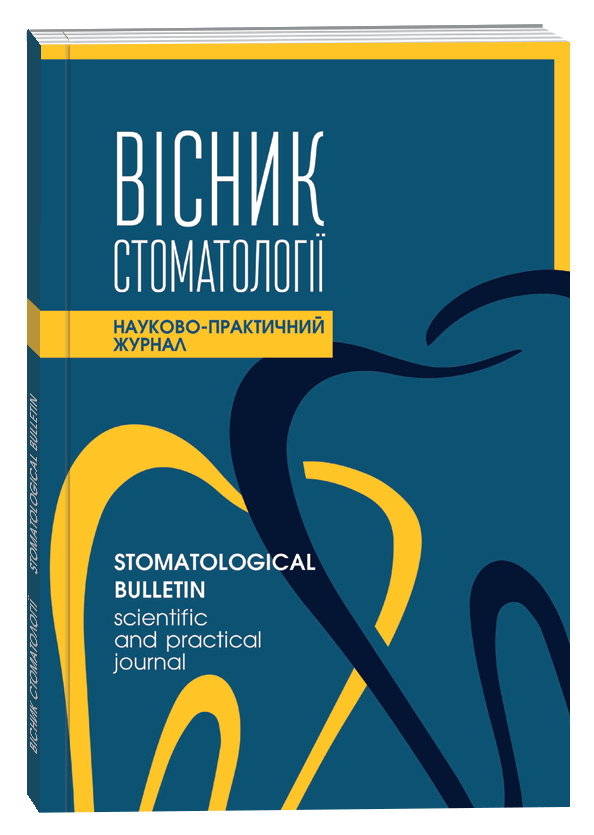ACCOMPANYING AND DENTAL DISEASE IN CHILDREN WITH CLEFT LIP AND PALATE
DOI:
https://doi.org/10.35220/2078-8916-2023-48-2.29Keywords:
dental morbidity, orthodontic devices, nonfusion of the lip and palateAbstract
Relevance. In recent years in Ukraine, children aged 0 to 14 years have a high incidence. Among them, 500–600 children are born annually with cleft lip and palate (CLP). This category of patients, according to various authors, have various comorbidities. The latter affect the course of the underlying disease, change the tissues of the oral cavity. Material and methods. 134 patients with CLP were examined. Clinical and laboratory assessment of somatic and dental status, statistical processing in MedStat software 5.4. Results and discussion. Among the 134 children with CLP, congenital comorbidities were found in 24% (n=32). Defects of the cardiovascular system were 75% (n=24). Cardiac surgery for these defects was performed in 50% (n=12) of cases before cheilorhynoplasty. Defects of the musculoskeletal system among congenital were found in 22% (n=7) of patients. The most common patients with CLP were: polyand syndactyly, hypermobility of the joints, wedge-shaped chest, asthenic type of constitution. Children with CLP in 23% (n = 33) cases had an enlarged thymus, usually 1–2 degrees. One to three acquired diseases were found in all children examined. The leading position was occupied by acute respiratory diseases – 45% (n=60) of children. This situation can be explained by the fact that the body's resistance to CLP in 40% (n=53) was reduced. Acquired respiratory and ENT diseases accounted for 30% and were detected in 40 patients. The next most common comorbidity in children with CLP is anemia, which occurred in 23% (n=30) of cases. Such conditions also contribute to the development of diseases of the gastrointestinal tract, dysbacteriosis. The latter was found in 16% (n=23) of children with CLP. Examination of the dental status of children with CLP revealed in 93.7% (n=134) pathological changes in both the hard tissues of the teeth and periodontal tissues. Teething disorders (inconsistent, odd, untimely eruption) were found in the vast majority of children with CLP. Lesions of hard tissues of teeth of non-carious origin in this group of children were more common than the average in healthy, their frequency was 34% (n=49). In the temporary occlusion cases of neonatal, very rarely – prenatal hypoplasia of tooth enamel, in permanent – systemic hypoplasia (chronological form or incisal-molar hypomineralization), as well as local hypoplasia of the enamel. Periodontal disease in children with CLP was mainly limited to generalized or localized chronic catarrhal gingivitis, often due to poor oral hygiene, masticatory disorders, orthodontic pathology, traumatic occlusion and removable orthodontic appliances. The frequency of generalized and localized gingivitis in the examined children was 61% (n=88). Conclusions. Concomitant congenital diseases of the cardiovascular system and musculoskeletal system in children with CLP determine the sequence of surgical interventions and require consultation with a cardiac surgeon, orthopedist. Acquired respiratory and ENT diseases predominate among the acquired diseases in children with CLP against the background of reduced immunity, which necessitates their treatment before and after surgical interventions on unfused tissues of the upper lip and palate. The high degree of caries and periodontal disease in this category of children requires constant support from a dentist. When treating children with CLP, there should be communication between doctors of various profiles to determine the stages and scope of diagnostic and therapeutic measures.
References
Crockett, D.J., & Goudy, S.L. (2014). Cleft lip and palate. Facial Plast Surg Clin North Am. 22(4), 573-86. doi: 10.1016/j.fsc.2014.07.002.
Taib, B.G., Taib, A.G., Swift, A.C., & van Eeden, S. (2015). Cleft lip and palate: diagnosis and management. Br J Hosp Med (Lond), 76(10), 584-5, 588-91. doi: 10.12968/hmed.2015.76.10.584.
Rodman, R.E., & Tatum, S. (2016). Controversies in the Management of Patients with Cleft Lip and Palate. Facial Plast Surg Clin North Am., 24(3), 255-64. doi: 10.1016/j.fsc.2016.03.004.
Tan, C.M.J., & Lewandowski, A.J. (2020). The Transitional Heart: From Early Embryonic and Fetal Development to Neonatal Life. Fetal Diagn Ther., 47(5), 373-386. doi: 10.1159/000501906.
Morselli, C., Mancini, P., Cirullo, A., Mangiavini, L., & Bassani, R. (2022). Congenital instability of cervical spine in a pediatric patient with cleft lip and palate Interdisciplinary Neurosurgery: Advanced Techniques and Case Management, 27, 101413









